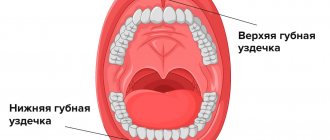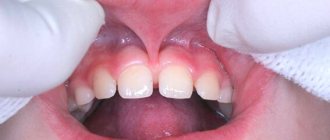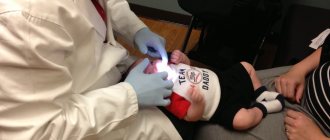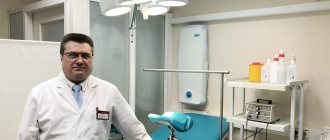The labial frenulum is a fold of mucous membrane (between the central incisors of the upper and lower teeth) that connects the lip and gum. It is involved in lip movement and articulation in speech. The health of the teeth, the correctness of the bite, the pronunciation of sounds, and the beauty of the smile depend on the quality and elasticity of the place where it is fixed to the gum.
The frenulum of the lip meets the gingival tissue at a distance of 5-8 mm from the necks of the anterior teeth. If it starts very close to the teeth, then it is considered to be shortened. It may also be that the frenulum is too wide. To avoid unpleasant consequences in the future or eliminate existing problems, doctors often recommend plastic surgery of the labial frenulum.
What is labial frenuloplasty?
The labial frenulum is a fold of mucous membrane that connects the lip and gum. Plastic surgery of the frenulum of the upper and lower lips is done to eliminate pathologies that can have unpleasant consequences in the form of impaired diction and the formation of malocclusion. This operation itself is very simple and has minimal contraindications. It is done if the frenulum is too short or too wide, which affects the position of the teeth and the condition of the gums. For example, due to a wide frenulum, a diastema may appear - a gap between the central incisors. In this case, either surgery using the classical method or laser plastic surgery of the upper lip frenulum will help.
Sometimes plastic surgery is performed on the frenulum of the tongue - the membrane connecting the lower part of the tongue and the mucous membrane of the lower jaw. In children, surgery promotes the correct formation of the bite and prevents speech defects; in adults, it is a necessary measure for effective prosthetics with a removable structure or implantation. Read more about tongue frenuloplasty here.
Frenules in the oral cavity
These small mucous strands can affect the clarity of speech, the aesthetics of a smile; in infants, the frenulum of the oral cavity can affect the quality of attachment to the breast, or the ability to suck a bottle. It is for this reason that parents should pay attention to these anatomical formations. If the frenulum(s) of the oral cavity are short, the baby will not be able to eat properly, attach to the breast, and therefore will get tired faster, remaining hungry. There can be no talk of any increase in the child’s weight or height. Parents should remember and be aware of this problem and be able to notice alarming symptoms. According to statistics, a large percentage of short frenulums are registered in children, on average every 14 children. If the problem is diagnosed in time, it is possible to avoid those complications that can cause short frenulum. Anatomy of the oral cavity There are three frenulums in the child’s oral cavity , and not one, as many parents believe. After all, the more “ famous ” is the frenulum of the tongue, which is attached to the underside of the tongue and sublingual space. The frenulum of the tongue is rightfully considered the most insidious, but at the same time practically the most important. In addition to the frenulum of the tongue, in the baby’s mouth there are also frenulums of the upper and lower lips, which are also assigned certain functions. The frenulum on the upper lip should be woven into the upper lip and into the mucous membrane of the gums, just above the level of the front incisors. The frenulum on the lower lip is woven in the same way as the upper lip. As a rule, a short frenulum in the mouth can be diagnosed in the parent department; this is more true for a short frenulum of the tongue. As for the rest of the frenulum of the oral cavity, diagnosis mainly occurs in the dentist's chair at a random appointment. There are cases when a tongue frenulum is not immediately diagnosed, and the frenulum in no way interferes with the feeding of the baby. But subsequently, the child may pronounce incorrectly defined sounds, and then the question of a short frenulum of the tongue comes up again, which, as a rule, is diagnosed at an appointment with a speech therapist. Upper lip frenulum When diagnosing a short frenulum, there are usually no difficulties, even for parents. To do this, you just need to carefully pull back the upper lip at rest and see at what level the mucous cord is attached. Normally, attachment should occur 5–8 mm from the neck of the child’s incisors. If the frenulum is attached lower or its attachment is not visible at all, then we can talk about a short frenulum. What are the dangers of having a short frenulum? In a newborn baby, a short frenulum on the upper lip can affect breastfeeding; the baby simply cannot position the upper lip correctly and correctly grasp the mother's breast. Only in this case can the frenulum of the upper lip be corrected in the maternity hospital. Fortunately, this happens quite rarely. At an older age, a short frenulum in the oral cavity can affect the aesthetics of a smile, since a gap is formed between the child’s front teeth - a diastema (trema). Typically, children are embarrassed by such diastemas, especially teenagers, and try to smile or talk less. Such gaps between teeth are considered dental defects that require orthodontic treatment, sometimes in combination with surgery. But it is worth remembering that an aesthetic defect is not the only problem that can be caused by a short frenulum of the upper lip; the most serious complication is problems with bite, namely the protrusion of the front incisors forward. The protrusion of the front incisors occurs as a result of pressure. The fact is that when talking or eating, the lips are involved, and the frenulum connects the lip and the alveolar process and pulls it along with it, while mechanically acting on the jaw in the area of the incisors, promoting their advancement forward. The solution to this problem is orthodontic, and requires a fairly large investment of time and money. In fairness, it is worth noting that such a scenario can only develop in children with permanent incisors; if the baby still has a milk bite, then there is no need to worry. Excessive tension of the gum mucosa can provoke inflammatory diseases in the area of the front incisors - gingivitis, periodontitis. As a result, the child may develop increased tooth sensitivity. Speech defects may also be characteristic of a short frenulum; the toddler cannot correctly pronounce some sounds that the baby uses his lips to pronounce, such as “o”, “u”, etc. In addition, inflammatory diseases in the gum area can cause caries in the area of the necks of the teeth. Due to the low attachment of the frenulum, a large amount of plaque accumulates in the incisor area, and it is quite difficult to remove. How does the correction happen? Correction can be done exclusively surgically, but it is worth remembering some features. Correction of the frenulum on the upper lip is indicated only after or during the eruption of the permanent incisors! Usually this is 6 - 8 years old; until this age, parents should not worry. It is not recommended to perform the operation before this period, with the only exception in the maternity hospital. Otherwise, such actions may result in bite pathology. A shortened and thick frenulum of the upper lip in a primary occlusion is not a pathology, but a variant of the norm; as the jaws grow, the frenulum can self-correct, i.e. stretch out and change its place of attachment. It is for these reasons that the most optimal time for correction is the time when all the permanent incisors on the upper jaw have erupted, and active eruption of the canines begins, or when the anterior permanent incisors are erupting, and when the lateral incisors are actively erupting. The fact is that when the frenulum is corrected at this time, the erupting teeth will move the teeth towards each other and the gap between the teeth will close on their own, and there will be no need for orthodontic treatment. If it was not possible to correct the frenulum in time, it is necessary to use orthodontic treatment, when the doctor places a “brace” on the front teeth, which will bring the incisors together. Surgical treatment Dentists can use 3 types of surgical treatment : Frenotomy - dissection; Frenectomy - excision; Frenuloplasty – relocation of the frenulum attachment site. Children can cut the frenulum on their own, and cases of such injuries are quite common. For example, if you fall or chew toys too hard, the frenulum may rupture, which is accompanied by bleeding and hematoma. In case of injury, you must immediately consult a dentist to decide the future fate of the injured frenulum. Frenectomy allows you to solve this problem, and even with trauma to the oral cavity, ruptures of the frenulum, as a rule, do not occur. The operations themselves are performed in a surgical clinic, using local anesthesia, and the procedure usually does not take more than 30 minutes. After cutting the frenulum, the doctor places sutures made of a special biomaterial that dissolves on its own, which avoids the unpleasant procedure of removing them. The recovery period after the procedure is not long and takes from several hours to several days. And as soon as the swelling subsides after the operation, parents note that the child begins to pronounce sounds more clearly, or grasps the mother’s breast more freely. The operation can be performed using various instruments - surgical scissors or a scalpel, or using a laser. Using the latter technique is the most acceptable, as it avoids stitches and significantly reduces the baby’s recovery time. Most often, the frenulum is corrected in young children using a scalpel, the amount of time spent is reduced, and immediate attachment to the chest is a prerequisite. Frenulum on the lower lip The frenulum of the lower lip may not be present or it may be forked. In order to diagnose a frenulum on the lower lip, it is necessary to retract the lower lip. At the same time, the frenulum itself becomes noticeable, which runs from the middle of the alveolar process of the lower jaw, intertwining below the area of the lower incisors, and attaching to the lower lip. Under normal conditions, the frenulum should be thin and almost invisible, in addition, it should be flush with the center line. If the baby's frenulum is thick, short and attached at the base of the lower incisors, the frenulum is short. Why is a short frenulum of the lower lip dangerous? By analogy with the frenulum on the upper jaw, the sucking function of a toddler may suffer. When sucking, the short frenulum pulls the lower lip along with it, thereby breaking the vacuum that is formed during sucking. The baby needs more effort, the baby quickly gets tired, remaining hungry and abandoning the breast. In this case, frenuloplasty can be performed in the maternity ward. A short frenulum can also cause malocclusion, inflammatory and carious diseases in the area of the lower front incisors. The formation of spaces between the lower anterior incisors is a rather rare phenomenon, but can still be diagnosed if the frenulum is woven into the area of the gingival papilla between the anterior incisors of the lower jaw. Treatment The operation can be performed on children of different ages, but most often these are children with fully erupted permanent incisors. No less often, the frenulum can be cut already in adulthood, when it comes to prosthetics of the lower jaw. The operation itself is carried out in a clinic, using local anesthesia, and 2 operations can be used to correct the frenulum - frenotomy, frenectomy. Tongue frenulum It is this frenulum that can influence the movement of the tongue; most often it limits this movement. The tongue is the most important organ in the oral cavity, which is involved in many functions - speech formation, nutrition, breastfeeding and much more. Normally, the mucous cord is woven from the inside of the tongue approximately in the middle, and connects to the sublingual space. The normal length of the frenulum is about 8 mm. If a toddler’s frenulum is attached almost to the tip of the tongue, then this is a clear indication for correction. This classic sign of a short frenulum of the tongue is not always found; there are other symptoms that can be used to diagnose its shortening. Doctors usually use a simple test that parents can use too. When the baby’s mouth is open, you need to ask her to touch the very roof of her mouth, and if the baby reaches without difficulty, everything is normal. But if a child experiences a painful reaction, or the child simply cannot perform this operation, this is a reason to contact a doctor. The only drawback of this test is the age restrictions for children; such a test can only be performed on children over 3 years old. If the baby is younger, then he can simply refuse to carry out such manipulation. There is also a set of tests for younger children; doctors usually ask or provoke the child to show his tongue. And at the same time, the doctor evaluates how much the baby’s tongue can come out of the mouth. Why is a short oral frenulum dangerous? Every mother should pay attention to feeding the baby, monitor his reaction, pay attention to the sounds the baby makes, and weight gain. With a short frenulum of the tongue, the baby simply cannot properly place his tongue under the mother’s nipple, it turns out that the baby cannot grasp the breast correctly, and “clicking” sounds may occur during feeding. In addition to inadequate breastfeeding and problems for the mother, the baby spends more effort to get enough, the baby's sucking activity gradually decreases, and the feeding time itself increases, during which the baby takes a short break. The baby tries to compensate for the greater amount of effort by clenching his jaws, and often when feeding, babies bite their mother's breast. Often such children set their own feeding schedule, since full saturation occurs over a longer period of time; usually babies eat approximately every two hours. Weight gain is at the lower limit of normal, or even lags behind. The frenulum may not be diagnosed in infancy, and can be detected during the period when the baby begins to actively talk. Babies with a short frenulum of the tongue cannot correctly pronounce quite a lot of sounds, namely those sounds in which the tongue should touch the palate or upper incisors - “r”, “sh”, “sch”, “ch”, “ry”, etc. Diagnosis of the frenulum often occurs at an appointment with a speech therapist, from where parents receive a referral to a dentist. Treatment Treatment can take place in two ways - surgical or speech therapy; often a combination of these two methods occurs. Parents should remember that the choice of treatment method lies entirely on the shoulders of the dentist, and not the speech therapist. Surgical correction of the frenulum The frenulum can be corrected in the maternity hospital, the operation is carried out in the obligatory presence of the mother, and after the operation the baby must be immediately applied to the breast. There are no nerve endings in the frenulum itself, but there are blood vessels; there are none in the place where the dissection occurs, therefore, there is no pain or bleeding. Babies can simply get scared, and applying to the breast is more of a calming maneuver. In young children, correction is most often carried out using a laser, which eliminates the need for stitches and reduces recovery time. In older children, namely school children, it is performed under local anesthesia. In this case, the doctor cuts the frenulum and applies sutures using a classic set of instruments. It is more advisable to use a laser scalpel. When using it, the time of the operation itself is reduced, and there is no need for sutures. After rehabilitation, the baby must follow a special gentle diet and perform the exercises recommended by the dentist or speech therapist. These exercises are aimed at training the frenulum. If the frenulum is not very shortened, then it is possible to solve the problem without surgery, but only if the child is less than 5 years old. Speech therapy exercises Exercises can be different, and the choice will depend on the age of the child. For the little ones, you can offer play exercises where the baby’s tongue will be used, for example, the “kitten” exercise - the baby is asked to lick a saucer like a kitten. You can use the “ horse ” exercise, ask the baby to click like a horse, while the tongue rises to the palate, tension and stretching of the frenulum occurs, which trains it. At the appointment, the speech therapist can massage the frenulum using special tools or with the help of hands. It is worth remembering that the child gets tired quite quickly, and unpleasant sensations, even pain, may occur. That is why the load must be increased gradually, and it is precisely this fact that is associated with the fact that speech therapy treatment does not give quick results, and in most cases it is impossible to do without surgical intervention. And when diagnosing a short frenulum, it is necessary to consult a speech therapist and a dentist, but the final word remains exclusively with the dentist.
What are the differences between upper and lower lip frenuloplasty?
Although the operations themselves to correct pathology on the upper and lower lips are similar, they require a different approach to rehabilitation. After plastic surgery of the lower lip frenulum, the wound takes longer to heal, about two weeks, while plastic surgery of the upper lip frenulum requires only a few days to recover. In the first case, anti-inflammatory therapy is often prescribed to prevent complications.
When should the procedure be performed?
The optimal age for surgery is 5-6 years. Children under 4 years of age are not subject to correction. The beginning of cutting off the mucous membrane should be done when the temporary front teeth have already completely fallen out, and the permanent incisors are at the stage of eruption.
What complications can be visualized during the procedure before the age of five: the formation of the jaw after the procedure, as a result of which repeated intervention may be necessary in the future; the child's upper lip performs only a third of the prescribed functions (the child does not speak, does not bite solid food, etc.).
When is lip frenuloplasty required?
The pathology of the labial frenulum does not always indicate that the patient requires surgery. Sometimes it is minor and does not cause any particular inconvenience. As a rule, surgery is necessary in the following cases.
- Diastema.
The excess gap between the central incisors tends to widen, causing the teeth to move forward and move apart in different directions. Also, constant stress on the gums leads to periodontitis. - Orthodontic treatment.
Correcting the bite with braces requires that the frenulum be of the correct shape and have an anatomical location. Therefore, before starting treatment, the orthodontist often sends the patient for plastic surgery. - Periodontal diseases.
A short frenulum can expose the roots of the teeth. - Complete prosthetics.
A short frenulum does not allow a removable denture to be firmly and securely fastened. This is one of the most common cases when plastic surgery of the lower lip frenulum is performed in adults.
Photo of a short frenulum of the upper lip in a child.
Pathology in a child
Problems that a child may have in the case of a tight or short frenulum: an interdental diastema (gap, gap) is formed; the smile becomes skewed, weakly expressed and unaesthetic; possible speech disorders, distortion of the pronunciation of different letters; the mucous fold pulls out the interdental papilla, which leads to malocclusion.
Content:
- Pathology in a child
- Indications for plastic surgery
- Who prescribes the procedure?
- When should the procedure be performed?
- Types of procedures
- Rehabilitation after the procedure
- Contraindications to plastics
Failure to eliminate the pathology can provoke a number of complications: it is difficult for infants to perform the sucking function; speech organs develop with deviations, as a result of which speech therapy problems are observed; difficulty chewing foods; the formation of pockets in the gums in which food can get stuck and rot, provoking a number of inflammatory processes and complex diseases of the oral cavity; the enamel becomes sensitive and teeth quickly deteriorate; formation of spaces between teeth.
A wide frenulum can cause the accumulation of pathological microflora, plaque, stone, and food debris in the teeth.
Is it necessary to perform labial frenuloplasty in children?
Pathology of the labial frenulum in a child can lead to many unpleasant consequences, both medical and aesthetic. Therefore, if a specialist recommends plastic surgery, you should definitely take his advice. In children, this anomaly can cause the following problems:
- The upper lip in newborns is actively involved in the sucking process along with the tongue, therefore, if the frenulum is shortened, the child will not be able to feed normally;
- A frenulum of the upper lip that is too short does not allow the correct pronunciation of labial sounds and some vowels, as a result of which the child will experience difficulties with diction;
- Frenum defects are directly related to malocclusion and chewing functions. Thus, there is a risk of digestive problems.
According to doctors, it is best to perform plastic surgery of the upper lip frenulum in children aged 5 to 8 years (the indications for surgery on the lower lip are identical). At this time, the child’s baby teeth are replaced by permanent teeth, and it is important that this process proceeds correctly. However, if necessary, plastic surgery of the upper lip frenulum can be performed in adults or adolescents. As for newborns, it is recommended that they undergo surgery only in case of serious nutritional disturbances.
Why are short bridles dangerous?
Short frenulum in the mouth can cause many unpleasant consequences. The first of them: the baby cannot attach to the breast correctly, so during feeding it expends a lot of effort, but at the same time receives a smaller volume of milk, and it is simply not enough to satiate. This is sometimes the reason for poor weight gain, but quite often mothers and doctors mistakenly look for the cause in a mythical lack of milk, or some disease, although, first of all, it is necessary to look into the oral cavity and assess the condition of the frenulum.
It is very important for parents to know and remember about this problem, because according to statistics, every 14th child has short frenulum in the oral cavity. If you notice this feature in time, then in the future you can avoid many problems and unpleasant consequences - disturbances in nutrition, speech, bite and, accordingly, facial aesthetics.
For the first time, doctors may notice a short frenulum in the baby’s mouth during the first examination, immediately after birth, and if the fact is confirmed, correction is carried out on the spot. This rule applies to a short frenulum of the tongue, but if the frenulum does not interfere with full natural feeding, the frenulum will not be trimmed in the maternity hospital. Symptoms of a short frenulum may appear later - the child may have difficulty pronouncing some sounds, in which case “treatment” will be carried out later, and, as a rule, in tandem with a speech therapist.
Methods of lip frenuloplasty
There are three main methods of lip frenuloplasty: frenotomy, frenectomy and frenuloplasty. The choice of technique depends on the characteristics of the pathology.
- Frenotomy is a dissection of the frenulum. It is performed when the process is too narrow and is not attached to the edge of the alveolar ridge. The frenulum is cut transversely.
- Frenectomy - excision of the frenulum. This method is used for excess soft tissue width, with the incision along the ridge.
- Frenuloplasty - relocation of the frenulum attachment site.
In all three cases, self-absorbable threads are used to suture wounds. The operation usually lasts about 15 minutes and is painless using local anesthesia.
Recently, laser lip frenuloplasty has become widespread. This operation is more expensive, but easier to tolerate. A focused laser beam removes excess tissue while sealing the edges of the wound. This means that there is no need for stitches, the operation is completely bloodless, and recovery takes less time. Laser plastic surgery of the upper lip frenulum in children is preferable to the classical technique, since it is performed with less trauma. Of course, we also recommend giving preference to laser frenuloplasty of the upper lip in adults.
How does the procedure work?
The form and duration of the operation to correct the lip frenulum directly depends on its type. Surgery using a scalpel or laser lasts about 10 minutes. The child must sit still in a chair until the operation is completed. During the procedure, the dental surgeon makes the necessary incision or resection. Then he puts stitches.
Plastic surgery using a laser does not require additional antibacterial treatment - the frenulum is sealed, which eliminates the further development of infection. This procedure lasts less than 10 minutes and is completely bloodless.
Before plastic surgery, the mucosal area is numbed with a special anesthetic gel.
Minor discomfort may occur for several hours after surgery. In the next few days, it is necessary to maintain careful hygiene and avoid eating hard and hot foods so as not to irritate the frenulum. The rehabilitation period is aimed at ensuring that the frenulum heals faster.
Post-operative care
The rehabilitation period takes one to two weeks. To avoid complications, you must follow your doctor's recommendations:
- monitor the hygiene of the oral mucosa and perform procedures prescribed by a specialist;
- exclude hot, sour and solid foods;
- undergo a follow-up examination with the surgeon who performed the operation;
- do gymnastics to strengthen the chewing muscles.
The above rules will help you return to your normal lifestyle in a short time and prevent deterioration in your health after lip frenuloplasty.
Are there any contraindications?
When deciding whether to undergo lip frenuloplasty, the doctor will definitely assess the risks and check for contraindications. There are few of them, since the operation is considered minimally invasive:
- recurrent pathologies of the oral mucosa;
- tendency to develop keloid scars;
- bleeding disorders;
- inflammatory diseases of the jaws;
- decompensated forms of chronic systemic diseases;
- general disorders - mental disorders, cerebral pathologies, oncological processes, exacerbations of chronic diseases.
How much does lip frenuloplasty cost?
The price for lip frenuloplasty usually starts at 3,000 rubles and reaches 5,000 - 6,000 rubles. In this case, there is usually no difference whether we are talking about the price of plastic surgery of the frenulum of the upper lip or the lower lip. Plastic surgery of the frenulum of the upper lip with a laser is more expensive and can cost from 3,500 to 8,000 rubles. Traditionally, the cost of the operation already includes anesthesia, but this must be clarified in advance. Parents often ask how much it costs to have upper lip frenuloplasty in children. Typically, the costs for this procedure are no different from those for surgery in adults.
Comments
Which doctor can give a referral for this operation?
Marina (06/14/2020 at 07:28 pm) Reply to comment
- You can get a referral after an examination by a dentist or periodontist, orthodontist, speech therapist, or neonatologist (for newborns). The operation itself is performed by a dental surgeon.
Editorial staff of the portal UltraSmile.ru (06/17/2020 at 09:07) Reply to comment
Write your comment Cancel reply
What pathologies require solutions?
Normally, the frenulum of the tongue starts from the tip of the organ and ends in the area of the lower incisors. It is located exactly in the center (bottom). These are the perfect sizes. The main pathology that occurs is a shortened frenulum, which leads to limited mobility of the tongue.
As for the frenulum of the lip (pathologies are mainly found on the upper one), then normally it should be located between the front incisors and at the base of the lip. Such a film can be very short, which will lead to tension on the mucous membrane, or excessively large and will overlap the front teeth.
Due to such pathologies, a complex of problems arises, without eliminating which you risk creating serious troubles in the child’s life. And they will have to be resolved over more than one year.
Is chipping a feature or a pathology?
Diastema can be considered a “highlight” if a person’s dentition is symmetrical and there are no malocclusions. The time has passed when ideal beauty was valued; nowadays, getting closer to the ideal has become quite simple. Now you need to be a person, to have individual characteristics that distinguish you from others. The perfectly straight, snow-white teeth of models that adorn the cover of every second glossy magazine no longer impress anyone. Shcherbinka in these conditions is used as a way to distinguish yourself and be remembered.
What do dentists think about this? Experts consider diastema as an aesthetic and functional defect of the dental system. As a rule, the gap between the incisors is combined with other malocclusions. Also, due to the incorrect relationship of antagonist teeth in the anterior section, secondary changes develop:
- the risk of developing caries and inflammatory processes in gum tissue increases;
- The gap does not always contribute to clarity of speech and correct pronunciation of all sounds.
And since the gap is regarded as a defect, dentists advise getting rid of it.










